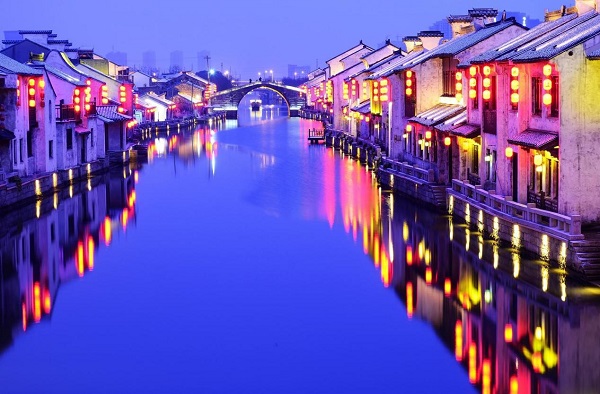2018-01-17 来源: 86Links

Was there no canal that was built for the peaceful means of helping the man in the street to live a stable live?
It is said, of course there is none, because canals were all built by ancient rulers. Since it was built by rulers, then it was to serve the ruler. This was understandable.
However, there is a canal that is an exception. The one who constructed this canal did not build this canal because he was a ruler. Rather, in order to build this canal, he became a ruler.
This person is the first monarch of Ancient China’s Wu country, Wu Taibo. The canal that Taibo built is a modern-day must-go place when travelling to Wuxi. It is called Bodu River, and is the earliest canal to be built in history.
Taibo was the eldest son of King Tai, the founder of the ancient Chinese Zhou Dynasty. At that time, in order to give the throne up to their third brother, Taibo and his second brother Zhongyong decided to “disappear” in Meili (the ancient town of Meili in Wuxi today). Wuxi at the time was almost a primitive society and used rudimentary methods of cultivation (burning the grass to fertilize the land and plant food in the dug-up pits). Hence, Taibo decided to teach the villagers to plant, feed and weave so that the indigenous villagers could live civilized lives.
The indigenous villagers must have felt that this man was formidable and that by mixing with him, they could live well. Then after obtaining the trust and support of the villagers, Taibo led them to dig the canal. The objective for digging the canal was pure. He wanted the canal to irrigate farmland on both banks of the canal.
As you know, in an agricultural society, when a place is irrigated and connected to a river, its residents would prosper and its economy would develop rapidly. Supported by this canal, the society grew from strength to strength and eventually established itself as the country of Wu. Taibo was then christened as the first monarch of Wu. 600 years later, Taibo’s descendant, Wu King Fuchai, used the Bodu River to construct canals in order to go on an expedition up north.
2000 years later, the Tang dynasty administration discovered the ruins of Bodu River and undertook reconstruction of this buried canal. After a few trials, the earliest canal in the world was connected to the Wuxi segment of the world’s longest canal, the Beijing-Hangzhou Grand Canal. This connected Wuxi and enabled it to become the hub of the entire region south of the Yangtze river.
Today, 3000 years later, I’ve come to the Bodu River. As I overlook both banks, I can no longer see the primitive society during Taibo’s era, but see a beautiful picture of Jiangnan!
Gentle southern women wash rice and clothes by the river, mischievous children play in the clear waters, literary men enjoy art on Qingming Bridge. Olden streets, allies, houses, bridges, temples, pagodas, snow-white walls, green and black ceramic play out vividly and form the scenes of the Ming and Qing dynasties. If not for the bright neon lights in the distance, I would not be able to tell if I was transported back to the olden times or still staying in the modern times.
I remembered when I was watching martial art dramas as a young boy, I asked my father: “Dad, why don’t we have magical architecture shown on TV at home?” My father, who did not understand much about ancient history, had no answer.
Only till today, when I walked into the old streets that could only be found on paintings that I understood. My hometown did not have ancient architecture because we did not have Bodu River nor Taibo.
I then remembered my first lesson in university, an old professor asked, what is culture?
Isn’t culture the ancient waters of the canal, the ancient harbor of Bodu, Nanchan temple and Qingming Bridge before my eyes? Isn’t it the simplicity of this street, this water, this house and this person?
At the end of 2007, the Wuxi government started restoration works on the streets in the vicinity of the banks of Bodu River. They expended maximum efforts in preserving the antique stylings of the architecture.
In March 2009, this canal has been redeveloped into a scenic district and officially opened to the public to showcase its refined and classic style.
In July 2017, we look back on the long 3000-year history of the canal. I would like to say “Jiangnan history is a promenade into anthropology”, “Amazing journey to the east”, “The out-of-print land of Chinese canal”, “The art corridor of eastern tradition” and other slogans used by the preservation and study groups set up by the government, the literary men and tourists are really befitting.
Why? Because all of the merits of wars gained by ancient emperors pale in comparison to this 43km stretch of river!
(The pictures from this article are retrieved from the internet.)
Chinese:
大家好~ 我们回头看中国的修建运河史,简直就是在看一部战争史,充满了杀伐、奴役、血泪。中国第一位皇帝——秦始皇,他修运河是为了消灭六国,一统天下;著名三国人物曹操,他修运河是为了向北征伐,建立功勋;而皇帝杨广建运河是为了征战古朝鲜半岛,消灭边患......
但是,难道就没有一条只是为了让老百姓安稳过日子,而修建的运河吗?
有人说,肯定没有啊,因为运河是古代统治者建的。既然是统治者建的,那肯定是为统治者服务的。这是无可厚非的嘛。
然而,有一条运河是个例外。修这条运河的人,不因为他是统治者才修这条河,而是因为修这条河,他才成为了统治者。
这个人就是中国古代吴国的第一位君主——吴泰伯。吴泰伯修的这条运河,是我们今天去中国无锡旅游的必去之地——伯渎河,也是历史上最早修建的运河。
吴泰伯是古代中国周王朝的奠基人——周太王的大儿子。当时吴泰伯和他的二弟仲雍,为了把王位让给三弟,决定“失踪”到梅里(今天的无锡梅里古镇)。当时的无锡几乎还是个原始社会,采用最原始的种植方式(把地上的草烧成灰做肥料,就地挖坑种植粮食。),非常落后。所以,吴泰伯决定教村里人种植、饲养、织布,让村里的土著人过上文明的生活。
那村里的土著人肯定感觉这个人好厉害啊,跟他混肯定能过上好日子。于是,泰伯在乡亲们的信任、支持下,带领他们挖运河。泰伯挖运河的目的很单纯。他就是想方便运河两岸的农田灌溉,排水防洪。
你知道,在农业社会,一个地方一旦通了水、连了河,那必然会让这个地方的人丰衣足食、经济迅速发展。吴国就是在这条运河的支持下,迅速发展壮大,建立成国。吴伯泰被拥立为吴国的第一位君主。六百年后,吴泰伯的后裔——吴王夫差,为了北上征战,而修借伯渎河来修运河。
两千年后,伯渎河的废弃遗址被唐朝政府发现,随后便对这个埋没的运河进行重建。几经波折,这条史上最早运河与世界最长运河京杭大运河的无锡段相连,为无锡城通联整个江南地区提供纽带。
三千年后的今天,我来到伯渎河上,向两岸看去,看到的不再是泰伯时期的“原始社会”,而是一幅精美绝伦的烟雨江南画!
温婉的江南女子在河边淘米、洗衣;顽皮的小孩在清澈的水里,嬉戏玩耍;文人墨客在清名桥上附庸风雅。古街、古巷、古宅、古桥、古庙、古塔,雪白的墙壁,青黑的瓦,历历在目,构成了明清时期的景色风光。若不是远处闪烁的霓虹灯光,我已经分不清自己处在古代还是现代。
想起小时候看武侠剧,我问爸爸:爸爸,我们家怎么没有电视上的神奇建筑啊?对古代历史不太了解的爸爸,无从答起。
直到今天,走进这个只有在画里才存在的古街,我才醒悟:家乡没有古建筑,只是因为我们缺了条伯渎河,少了个吴泰伯。
又想起我大学时的第一堂课,老教授提问:文化是什么?
文化不就是眼前的运河古水、伯渎古港、南禅古寺、清名古桥吗?不就是简单的这街、这水、这屋、这人吗?
2007年年底,无锡市政府对伯渎河岸的街区开展了修复工作。最大限度地保持了岸边古色古香的建筑风格。
2009年3月,这条古运河已被建成风景区,正式对公众开放,向世界展示她的温和文雅、古典风格。
2017年7月,回望3000年的悠悠运河史。我想说,“江南历史人文景观长廊”、“神奇的东方之旅”、“中国运河的绝版地”、“东方民俗的艺术走廊”,这些被全国政协的大运河保护与申遗考察团、文人游客等赋予的称号,确实名副其实。
为什么?只是因为——帝王们的征战功勋,都不如这43公里的悠悠河水!
(文中图片源于互联网)